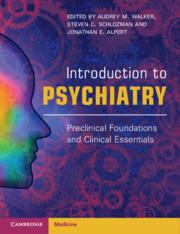Book contents
- Introduction to Psychiatry
- Introduction to Psychiatry
- Copyright page
- Contents
- Contributors
- 1 Introduction
- 2 Clinical Neuroscience
- 3 Introduction to the Patient Interview
- 4 Mood Disorders
- 5 Schizophrenia Spectrum and Other Psychotic Disorders
- 6 Anxiety Disorders
- 7 Obsessive-Compulsive and Related Disorders
- 8 Disorders Related to Stress and Trauma
- 9 Substance Use Disorders
- 10 Personality Disorders
- 11 Neurocognitive Disorders
- 12 Feeding and Eating Disorders
- 13 Child Psychiatry and Neurodevelopmental Disorders
- 14 Sleep Disorders
- 15 Psychopharmacology and Neurotherapeutics
- 16 Psychosocial Interventions
- 17 Psychiatric Evaluation in the Medical Setting
- 18 Psychiatry of Gender and Sexuality
- 19 Health Policy and Population Health in Behavioral Health Care in the United States
- 20 Global Health and Mental Health Care Delivery in Low-Resource Settings
- Index
- References
4 - Mood Disorders
Published online by Cambridge University Press: 22 July 2021
- Introduction to Psychiatry
- Introduction to Psychiatry
- Copyright page
- Contents
- Contributors
- 1 Introduction
- 2 Clinical Neuroscience
- 3 Introduction to the Patient Interview
- 4 Mood Disorders
- 5 Schizophrenia Spectrum and Other Psychotic Disorders
- 6 Anxiety Disorders
- 7 Obsessive-Compulsive and Related Disorders
- 8 Disorders Related to Stress and Trauma
- 9 Substance Use Disorders
- 10 Personality Disorders
- 11 Neurocognitive Disorders
- 12 Feeding and Eating Disorders
- 13 Child Psychiatry and Neurodevelopmental Disorders
- 14 Sleep Disorders
- 15 Psychopharmacology and Neurotherapeutics
- 16 Psychosocial Interventions
- 17 Psychiatric Evaluation in the Medical Setting
- 18 Psychiatry of Gender and Sexuality
- 19 Health Policy and Population Health in Behavioral Health Care in the United States
- 20 Global Health and Mental Health Care Delivery in Low-Resource Settings
- Index
- References
Summary
Over the years, attempts have been made to classify depressive syndromes based on various criteria. For several decades, the term reactive depression was used to describe cases involving an obvious precipitant, whereas endogenous depression lacked a recent stressor. Alternatively, the term secondary depression has been used in reference to cases related to a defined medical condition, as opposed to examples of primary depression. In the current classification scheme, the Diagnostic and Statistics Manual of Mental Disorders, 5th edition (DSM-V) lists fifteen distinct diagnoses related to disorders of mood, which are shown in Table 4.1. Eight of these disorders are considered depressive disorders, whereas seven categorize patients within the bipolar spectrum of illness.
- Type
- Chapter
- Information
- Introduction to PsychiatryPreclinical Foundations and Clinical Essentials, pp. 70 - 101Publisher: Cambridge University PressPrint publication year: 2021



